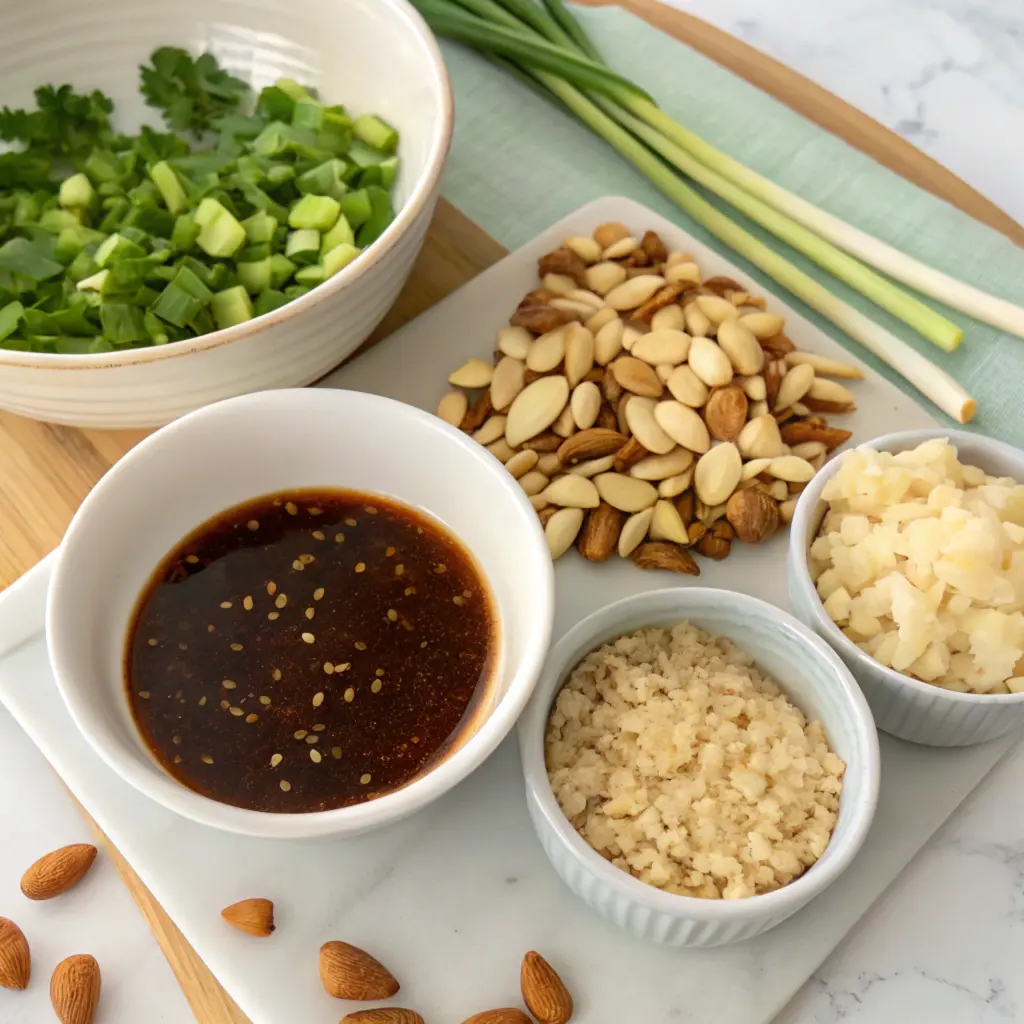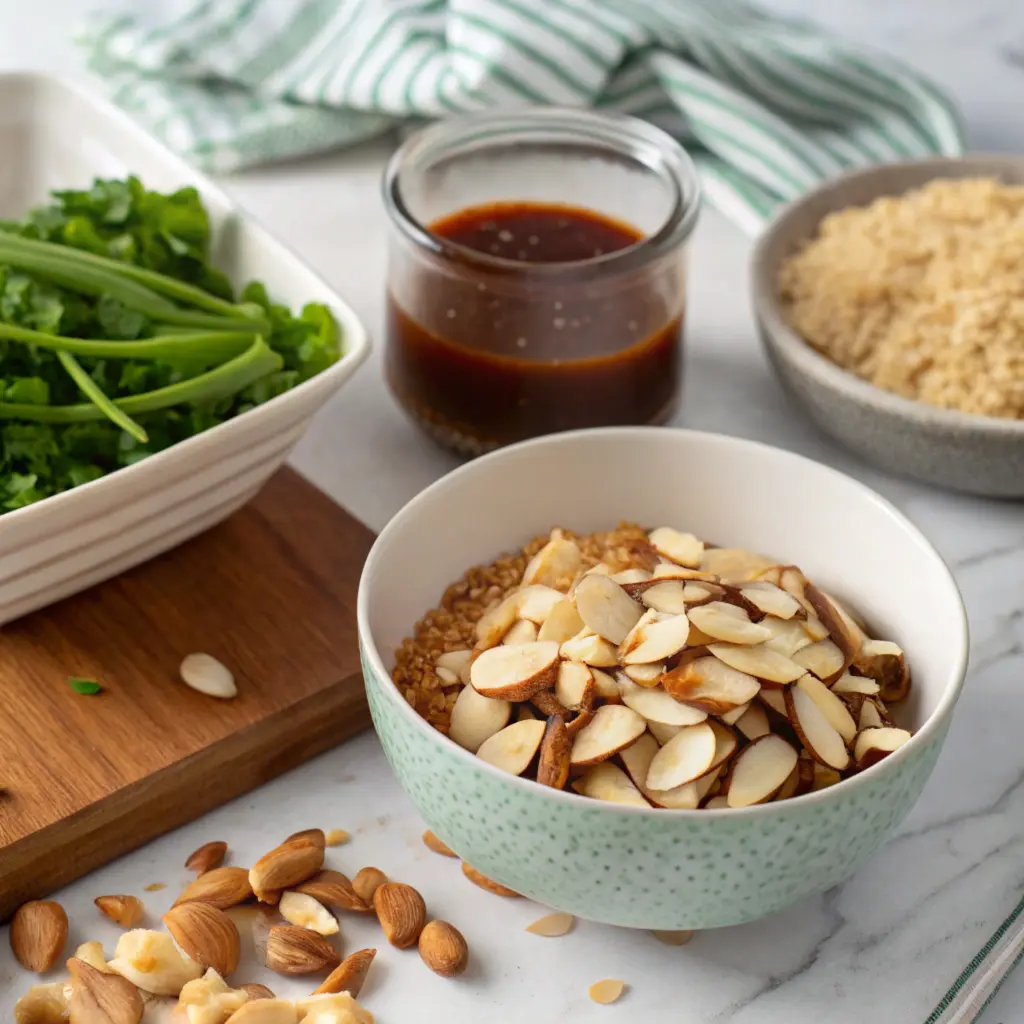Table of contents
- Introduction
- Ingredients Overview
- Tools Required
- Step-by-Step Preparation of Chopped Almonds
- Crafting the Asian Sauce
- Combining Chopped Almonds with the Asian Sauce
- Serving Suggestions
- Health Benefits of Chopped Almonds in Asian Sauce
- Common Mistakes and How to Avoid Them
- Storage and Shelf Life
- Variations of the Recipe
- Frequently Asked Questions (FAQ)
- What is almond sauce made of?
- How to make chopped almonds?
- What do you eat almond spread with?
- Can I use almond butter instead of chopped almonds?
- How can I make the sauce less salty?
- What is the best way to toast almonds for the sauce?
- How long does the sauce last in the fridge?
- Can I add other nuts to the sauce?
- Conclusion

Delicious, easy-to-make Asian sauce paired with Chopped Almonds and Asian Sauce Recipe for an exotic twist. Perfect for elevating any dish.
Introduction
If you are in search of a flavorful way to incorporate nuts into your Asian cooking, look no further. This chopped almonds and Asian sauce recipe offers the perfect balance of savory and nutty flavors, blending the creaminess of almonds with the vibrant spices of traditional Asian sauces. This versatile sauce works wonderfully as a dip, marinade, or stir-fry addition, offering both taste and nutrition.
Chopped almonds not only add texture but also boost the nutritional value of this sauce. The recipe is quite simple, and with a few essential ingredients, you can create a rich, creamy Asian sauce that will elevate your culinary experience. For more information on the benefits of incorporating almonds into your diet, check out this article on almond nutrition benefits. Additionally, you can explore different types of Asian sauces to see which flavors might suit your taste best.
Ingredients Overview
Breakdown of Ingredients for Asian Sauce
To create this chopped almonds and Asian sauce recipe, you will need a few pantry staples that are common in Asian cuisine:
- Soy Sauce: Provides the salty, umami base flavor.
- Rice Vinegar: Adds a tangy edge that balances the nuttiness.
- Sesame Oil: Infuses the sauce with a distinct toasted aroma.
- Garlic and Ginger: Fresh garlic and ginger provide a sharp, spicy undertone.
- Chopped Almonds: The star of this recipe, providing crunch, creaminess, and extra nutrients.
Details on Chopped Almonds and Their Benefits
Chopped almonds are rich in healthy fats, protein, and fiber. They add a fantastic texture to the sauce, making it both satisfying and wholesome. Almonds are also known for their benefits to heart health, as well as their ability to aid in weight management due to their high satiety factor. For an in-depth look at the health benefits of almonds, visit WebMD’s guide on almonds.
Tools Required
Essential Kitchen Tools
To make the chopped almonds and Asian sauce recipe, you will need the following tools:
- Cutting Board and Chef’s Knife: For chopping the almonds. Make sure you use a sturdy knife for a consistent chop.
- Small Saucepan: To mix and cook the sauce.
- Mixing Bowl: For combining all ingredients thoroughly.
- Food Processor (Optional): If you prefer a quicker method for chopping almonds.
Safety Tips for Chopping Nuts
Chopping almonds can be tricky because of their small size and round shape. To avoid injuries, always use a sharp knife and keep the almonds from rolling by pressing them down with the flat side of the blade before cutting.
Step-by-Step Preparation of Chopped Almonds
Techniques for Chopping Almonds
The key to this chopped almonds and Asian sauce recipe is achieving the perfect chop. Follow these steps:
- Spread the Almonds Evenly: Place the almonds on a cutting board and ensure they are evenly spread out to prevent accidents.
- Hold the Knife Properly: Use a chef’s knife and hold it with a firm grip, keeping your fingers curled under for safety.
- Chop with Consistent Pressure: Apply consistent pressure, rocking the knife back and forth to create evenly chopped pieces.
Tips for Consistent Chopping Size
To ensure the almonds are chopped evenly:
- Batch Chopping: Chop in small batches rather than all at once.
- Use a Food Processor: Pulse almonds briefly to achieve an even consistency without turning them into almond meal.
Alternatives to Hand-Chopping
If you prefer a quicker option, a nut grinder or food processor works well. Just make sure not to over-process the almonds, as the goal is to maintain some texture in the sauce.
Crafting the Asian Sauce
Ingredients Breakdown for Asian Sauce
To create a balanced and flavorful Asian sauce, you will need:
- 2 tablespoons soy sauce
- 1 tablespoon rice vinegar
- 1 tablespoon sesame oil
- 1 teaspoon grated fresh ginger
- 1 teaspoon minced garlic
- 2 tablespoons honey or maple syrup (optional, for a sweeter profile)
Detailed Steps to Prepare the Sauce
- Heat the Sesame Oil: In a small saucepan, heat the sesame oil over medium heat until it becomes fragrant.
- Add Ginger and Garlic: Add the grated ginger and minced garlic, sautéing for about 1 minute until fragrant.
- Mix in Soy Sauce and Vinegar: Pour in the soy sauce and rice vinegar, stirring well to combine.
- Sweeten if Desired: Add honey or maple syrup if you prefer a slightly sweeter sauce. Stir until well integrated.
- Cool Down: Remove from heat and let the sauce cool before adding the chopped almonds.
Importance of Flavor Balance in Asian Sauces
Asian sauces often revolve around a balance of salty, sweet, sour, and umami flavors. The soy sauce brings saltiness and umami, while rice vinegar adds acidity. Sesame oil provides richness, and ginger and garlic add aromatic depth. Adjust these flavors to suit your taste.
Combining Chopped Almonds with the Asian Sauce
Steps for Mixing Almonds with the Sauce
Once the sauce has cooled to room temperature:
- Add the Chopped Almonds: Gradually fold the chopped almonds into the sauce, ensuring they are evenly coated.
- Mix Thoroughly: Stir until the almonds are distributed uniformly throughout the sauce.
- Taste and Adjust: Taste the mixture, adjusting the seasoning as needed. You may add a bit more soy sauce or rice vinegar based on your preference.
Tips for Ensuring Even Distribution
- Use a Rubber Spatula: This helps scrape down the sides of the bowl and ensures everything is mixed evenly.
- Mix in Small Batches: To get a better consistency, mix the almonds in small batches if you’re making a large quantity.
Adjusting Texture and Consistency
For a thicker sauce, let it simmer for an extra minute or two to reduce slightly. Alternatively, you can add a teaspoon of cornstarch mixed with water to thicken the sauce without affecting its flavor.
Serving Suggestions
Dishes that Pair Well with Chopped Almonds and Asian Sauce
This chopped almonds and Asian sauce recipe is highly versatile and can be used in several dishes:
- Stir-Fry Vegetables: Add a spoonful of sauce to your favorite vegetable stir-fry for a boost of flavor and texture.
- Grilled Chicken: Use the sauce as a topping for grilled chicken or as a marinade beforehand.
- Rice or Noodle Bowls: Drizzle the sauce over steamed rice or noodles to enhance the flavor profile.
For more pairing ideas, visit BBC Good Food’s guide on Asian recipes.
Health Benefits of Chopped Almonds in Asian Sauce
Almonds as a Nutritional Powerhouse
Almonds are packed with vitamin E, magnesium, and fiber, making them an excellent addition to almost any meal. They help improve heart health by reducing LDL cholesterol and are linked to better blood sugar control due to their healthy fats and protein.
Health Benefits of Common Asian Sauce Ingredients
Ingredients like soy sauce, garlic, and ginger are more than just flavorful—they also offer nutritional benefits. Garlic is well-known for its immune-boosting properties, and ginger has anti-inflammatory effects. Soy sauce, albeit high in sodium, can provide small amounts of iron, magnesium, and potassium.
For more on the health benefits of soy sauce and its alternatives, visit this health benefits guide.
Common Mistakes and How to Avoid Them
Overcooking the Sauce
One common mistake is overcooking the sauce, which can result in a burnt or bitter taste. Always cook on medium heat and remove from the heat as soon as all ingredients are well combined.
Chopping Almonds Too Fine or Too Coarse
Avoid over-chopping the almonds into a fine powder, as this will affect the texture of the sauce. Conversely, chopping them too coarsely will make it hard for them to mix well.
Balancing Sweet and Savory Flavors
Balancing flavors can be tricky, especially if you add sweet elements like honey. Always start with smaller amounts, taste, and adjust incrementally.
Storage and Shelf Life
How to Store Leftover Asian Sauce with Chopped Almonds
Store any leftover sauce in an airtight container in the refrigerator for up to 5 days. The chopped almonds will continue to absorb some of the moisture, making the sauce thicker over time. Stir well before use.
Tips for Reheating Without Losing Flavor or Texture
To reheat, use low heat and stir frequently. If the sauce has thickened too much, add a splash of water or broth to return it to the desired consistency.
Variations of the Recipe
Substitutions for Different Dietary Needs
- Gluten-Free: Use tamari or coconut aminos instead of soy sauce for a gluten-free version.
- Vegan: Ensure you use maple syrup instead of honey, and check the labels on all other ingredients.
Creative Additions to Customize the Recipe
- Red Pepper Flakes: For those who enjoy spice, add a pinch of red pepper flakes.
- Lime Juice: A squeeze of fresh lime juice can add brightness and acidity to the sauce.
- Chopped Fresh Herbs: Cilantro or Thai basil can add an extra layer of flavor and freshness.
Frequently Asked Questions (FAQ)
What is almond sauce made of?
Almond sauce is typically made from chopped or ground almonds combined with ingredients like soy sauce, garlic, ginger, and other seasonings that create a creamy and savory mixture suitable for many dishes.
How to make chopped almonds?
Chopped almonds can be made by placing whole almonds on a cutting board and using a sharp knife to chop them into smaller pieces. Alternatively, a food processor can be used to pulse the almonds until they are evenly chopped.
What do you eat almond spread with?
Almond spread can be enjoyed with a variety of foods, including toast, fresh fruit, crackers, or even stirred into oatmeal or smoothies for added richness and nutty flavor.
Can I use almond butter instead of chopped almonds?
Yes, you can use almond butter as a substitute for chopped almonds to create a smoother sauce. Just reduce the amount of liquid slightly to maintain the desired consistency.
How can I make the sauce less salty?
To reduce the saltiness, use low-sodium soy sauce or dilute the sauce with a bit of water or unsalted broth.
What is the best way to toast almonds for the sauce?
Toast the almonds in a dry skillet over medium heat, stirring frequently until they become golden and fragrant. This will add a deeper, nuttier flavor to the sauce.
How long does the sauce last in the fridge?
The sauce can last up to 5 days in an airtight container in the refrigerator. Stir well before using, as the almonds may absorb some of the moisture.
Can I add other nuts to the sauce?
Absolutely! Cashews, peanuts, or even walnuts can be added to the sauce for a different texture and flavor profile.
Conclusion
This chopped almonds and Asian sauce recipe is a great way to add nutty flavor and rich nutrition to your dishes. Whether you use it as a dip, marinade, or topping, this versatile sauce can adapt to many culinary applications. Don’t hesitate to experiment with different ingredient combinations to make this sauce uniquely your own.
